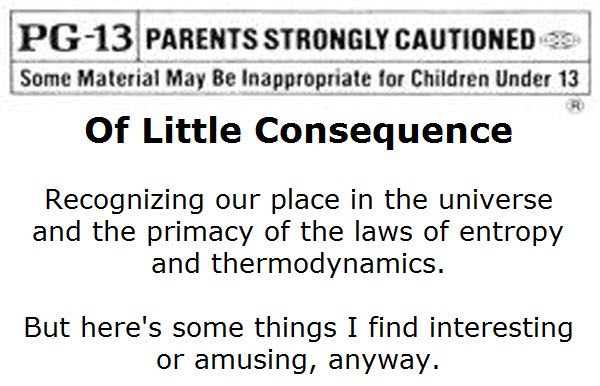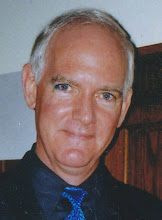Tuesday, April 27, 2010
Monday, April 26, 2010
Friday, April 23, 2010
The Rocketdyne F1 rocket engine
The F1 is the most powerful single rocket engine ever developed. The F1 is a liquid-fueled engine, burning RP-1 (kerosene) as the propellant, and LOX (liquid oxygen) as the oxidizer. The Apollo/Saturn V rocket which sent Americans to the moon, had 5 (!) F1 engines powering its first stage. Each indivual F1 had a 55,000-horsepower gas-generator turbine, just to push the fuel and oxidizer into the combustion chamber. Each of the F1 engines produces more than 1 1/2 million foot-pounds of thrust, and each one has more power than all three of the Space Shuttle's main engines combined.
The Saturn V rocket was used from 1967-1973, with thirteen launches with no loss of payload -- it weighed more than 6 1/2 million pounds and was only one foot shorter than St. Paul's Cathedral in London.
Each of the F1 engines would use up and burn enough fuel and oxidizer at a rate to empty a 30,000-gallon US swimming pool, in less than 9 seconds.
These engines in their 2 1/2 minutes of use, propelled the huge Saturn V vehicle to an altitude of 42 miles (68 km) and a speed of 6,164 miles per hour (9,920 km/h) and burning 2,000,000 kilograms (4,400,000 lb) of propellant.
All in all, these are the individually and collectively, the most powerful machines ever created by mankind.
The Saturn V rocket was used from 1967-1973, with thirteen launches with no loss of payload -- it weighed more than 6 1/2 million pounds and was only one foot shorter than St. Paul's Cathedral in London.
Each of the F1 engines would use up and burn enough fuel and oxidizer at a rate to empty a 30,000-gallon US swimming pool, in less than 9 seconds.
These engines in their 2 1/2 minutes of use, propelled the huge Saturn V vehicle to an altitude of 42 miles (68 km) and a speed of 6,164 miles per hour (9,920 km/h) and burning 2,000,000 kilograms (4,400,000 lb) of propellant.
All in all, these are the individually and collectively, the most powerful machines ever created by mankind.
Thursday, April 15, 2010
Meteor Over Milwaukee
Could almost be a song title...
In any case, several people have suggested that I personally was responsible for this, and that my aim was imperfect; the likely target being the Milwaukee Brewers. I would like to categorically deny this, as I rather like the Brewers. In any case, it requires a great deal of effort and expense on my part to -- with any reasonable degree of accuracy -- divert and direct the orbits of Kuiper Belt Objects , and as a result I'm rather sparing in these activities.
In any case, several people have suggested that I personally was responsible for this, and that my aim was imperfect; the likely target being the Milwaukee Brewers. I would like to categorically deny this, as I rather like the Brewers. In any case, it requires a great deal of effort and expense on my part to -- with any reasonable degree of accuracy -- divert and direct the orbits of Kuiper Belt Objects , and as a result I'm rather sparing in these activities.
Friday, April 9, 2010
The 'Sprint' ABM missile - Martin-Marietta and AT&T
INHO the most interesting small missile system ever invented/constructed by man.
"The Sprint was a two-stage, solid-fuel anti-ballistic missile, armed with a W66 enhanced radiation thermonuclear warhead(eg. a 'neutron bomb"). It was designed as the short-range high-speed counterpart to the longer-range LIM-49 Spartan as part of the Sentinel program. Sentinel never became operational, but the technology was deployed briefly in a downsized version called the Safeguard program. The Sprint, like the Spartan, was in operational service for only a few months in the Safeguard program, from October 1975 to early 1976. A combination of high costs, congressional opposition, and questionable efficacy resulted in a very short operational period."
(wikipedia)
The Sprint was a two-state missile, which was first shot out of its silo by a powder charge, and then the first stage ignited: burning for only about 1.5 seconds, this solid-fueled rocket motor accelerated the missle at over 100 G's (!), burned out and then the second stage ignited. At this point due to air friction, the surface of the missile itself was hotter than an acetylene welding torch, and yet the ground control radar needed to penetrate this high-temperature plasma, and still communicate with the missile. AT&T designed this system and the computers and support needed to do so: a superlative technical achievement...
The supporting radar systems -- to communicate with the missile in flight -- needed to project and maintain a radar beam of more than One Million Watts (1MW), in a focused direction of less than one second of arc, and instantaneously upgrade the aiming and timing of this radar beam, to maintain communication.
So, all in all, your AT&T-enabled IPhone is multiple orders of magnitude, more pathetic. :)
The linked film shows the Sprint in actual operation: the first part (where it is launched) is shown in 1/5 slow-motion -- where the missile is ejected out of its silo and the first stage is ignited -- otherwise it would not be very visible.
The second part is in real-time: yes, it really is THAT FAST.
As mentioned, this weapon used an 'enhanced radiation' warhead of still-classified design (a 'neutron bomb') to attempt as a last-minute intercept of an incoming re-etnry vehicle containing a nuclear warhead. The purpose was to disable, destroy or disarm the arming mechanism of that warhead, due to an intense flux of neutrons generated by the Sprint warhead detonation.
Details about the design, purpose and politcal future of such a warhead ("the Neutron Bomb") are readily available in "The Truth About The Neutron Bomb', written by Sam Cohen -- the actual designer of the device.
ISBN 0-688-01646-4
Copyright 1983 by Sam T. Cohen.
"The Sprint was a two-stage, solid-fuel anti-ballistic missile, armed with a W66 enhanced radiation thermonuclear warhead(eg. a 'neutron bomb"). It was designed as the short-range high-speed counterpart to the longer-range LIM-49 Spartan as part of the Sentinel program. Sentinel never became operational, but the technology was deployed briefly in a downsized version called the Safeguard program. The Sprint, like the Spartan, was in operational service for only a few months in the Safeguard program, from October 1975 to early 1976. A combination of high costs, congressional opposition, and questionable efficacy resulted in a very short operational period."
(wikipedia)
The Sprint was a two-state missile, which was first shot out of its silo by a powder charge, and then the first stage ignited: burning for only about 1.5 seconds, this solid-fueled rocket motor accelerated the missle at over 100 G's (!), burned out and then the second stage ignited. At this point due to air friction, the surface of the missile itself was hotter than an acetylene welding torch, and yet the ground control radar needed to penetrate this high-temperature plasma, and still communicate with the missile. AT&T designed this system and the computers and support needed to do so: a superlative technical achievement...
The supporting radar systems -- to communicate with the missile in flight -- needed to project and maintain a radar beam of more than One Million Watts (1MW), in a focused direction of less than one second of arc, and instantaneously upgrade the aiming and timing of this radar beam, to maintain communication.
So, all in all, your AT&T-enabled IPhone is multiple orders of magnitude, more pathetic. :)
The linked film shows the Sprint in actual operation: the first part (where it is launched) is shown in 1/5 slow-motion -- where the missile is ejected out of its silo and the first stage is ignited -- otherwise it would not be very visible.
The second part is in real-time: yes, it really is THAT FAST.
As mentioned, this weapon used an 'enhanced radiation' warhead of still-classified design (a 'neutron bomb') to attempt as a last-minute intercept of an incoming re-etnry vehicle containing a nuclear warhead. The purpose was to disable, destroy or disarm the arming mechanism of that warhead, due to an intense flux of neutrons generated by the Sprint warhead detonation.
Details about the design, purpose and politcal future of such a warhead ("the Neutron Bomb") are readily available in "The Truth About The Neutron Bomb', written by Sam Cohen -- the actual designer of the device.
ISBN 0-688-01646-4
Copyright 1983 by Sam T. Cohen.
Thursday, April 8, 2010
Wednesday, April 7, 2010
"I Have a Little List..."
The list of other countries capable of producing LEU of 19.75% includes Brazil, China, France, Germany, India, Israel, Japan, Holland, North Korea, South Korea, Pakistan, Russia, the United Kingdom, and the United States. There would be nothing extraordinary about Iran joining this list, and none of the others on it except N. Korea is being sanctioned-- and that is for constructing a bomb, which Iran is not doing. Argentina was sanctioned neither for enriching to 19.75% nor for selling that stock of LEU to Iran! And South Korea was never sanctioned for secretly enriching to 77%, near bomb grade, something Iran has never been accused of.
Tuesday, April 6, 2010
Xena, the Warrior Princess (and Gabrielle)
The dwarf planet (or trans-Neptunian or Kuiper belt object) now called 'Eris' has a moon, called 'Dysnomia.'
Mike Brown - the discoverer - and other researchers referred colloquially to the two as 'Xena' and 'Gabrielle', after Lucy Lawless' TV character and her sidekick . Since these didn't follow the international naming conventions and were thus likely to not be approved, they proposed 'Eris' and 'Dysnomia': a minor Greek god and her daughter, thus following the accepted protocols.
'Dysnomia' -- means "Lawlessness" :)
Mike Brown - the discoverer - and other researchers referred colloquially to the two as 'Xena' and 'Gabrielle', after Lucy Lawless' TV character and her sidekick . Since these didn't follow the international naming conventions and were thus likely to not be approved, they proposed 'Eris' and 'Dysnomia': a minor Greek god and her daughter, thus following the accepted protocols.
'Dysnomia' -- means "Lawlessness" :)
Eris (in the center) ande Dysnomia (on the left) taken by the Hubble Space Telecople.
Subscribe to:
Comments (Atom)









